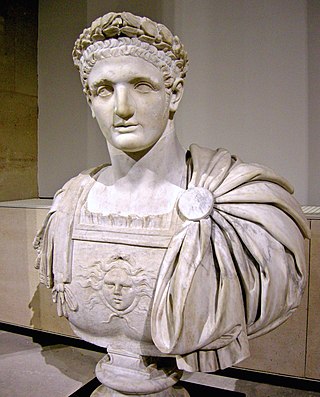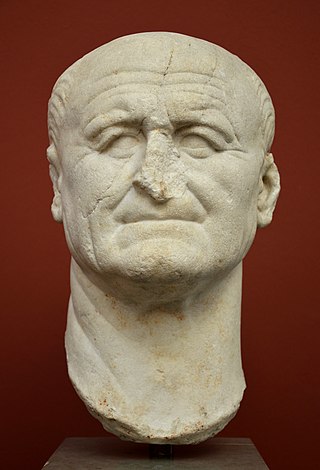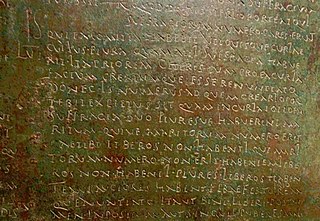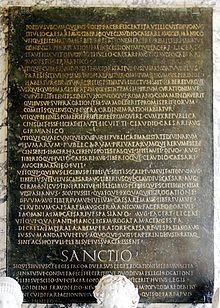
Domitian was Roman emperor from 81 to 96. The son of Vespasian and the younger brother of Titus, his two predecessors on the throne, he was the last member of the Flavian dynasty. Described as "a ruthless but efficient autocrat", his authoritarian style of ruling put him at sharp odds with the Senate, whose powers he drastically curtailed.

Vespasian was Roman emperor from 69 to 79. The last emperor to reign in the Year of the Four Emperors, he founded the Flavian dynasty, which ruled the Empire for 27 years. His fiscal reforms and consolidation of the empire brought political stability and a vast building program.

The Arch of Titus is a 1st-century AD honorific arch, located on the Via Sacra, Rome, just to the south-east of the Roman Forum. It was constructed in c. 81 AD by Emperor Domitian shortly after the death of his older brother Titus to commemorate Titus's official deification or consecratio and the victory of Titus together with their father, Vespasian, over the Jewish rebellion in Judaea.

The Archbasilica of Saint John Lateran is the Catholic cathedral of the Diocese of Rome in the city of Rome, and serves as the seat of the bishop of Rome, the pope. The only "archbasilica" in the world, it lies outside of Vatican City proper, which is located approximately four kilometres northwest. Nevertheless, as properties of the Holy See, the archbasilica and its adjoining edifices enjoy an extraterritorial status from Italy, pursuant to the terms of the Lateran Treaty of 1929. Dedicated to the Christ, in honor of John the Baptist and John the Evangelist, the place name, Laterano (Lateran) comes from an ancient Roman family (gens), whose palace (domus) grounds occupied the site; the adjacent Lateran Palace was the primary residence of the pope until the Middle Ages.

The Roman emperor was the ruler and monarchical head of state of the Roman Empire, starting with the granting of the title augustus to Octavian in 27 BC. The term emperor is a modern convention, and did not exist as such during the Empire. When a given Roman is described as becoming emperor in English, it generally reflects his accession as augustus, and later as basileus. Another title used was imperator, originally a military honorific, and caesar, originally a cognomen. Early emperors also used the title princeps alongside other Republican titles, notably consul and pontifex maximus.

The Apostolic Palace of the Lateran, informally the Lateran Palace, is an ancient palace of the Roman Empire and later the main papal residence in Rome.
The Verulamium Forum Inscription is one of the many Roman inscriptions in Britain. It is also known as the "Basilica inscription", as it is believed to have been attached to the basilica of Verulamium. The surviving fragments have been reconstructed as a large dedication slab on display at Verulamium Museum.

The Basilica of Saint Mary of the Altar in Heaven is a titular basilica and conventual church of the Franciscan Convent of Aracoeli located the highest summit of the Capitoline Hill in Rome, Italy. From 1250-1798 it was the headquarters of the General Curia of the Order of Friars Minor as well as being one of the city's principal civic churches. It is still the designated church of the city council of Rome, which uses the ancient title of Senatus Populusque Romanus. The present cardinal priest of the Titulus Sanctae Mariae de Aracoeli is Salvatore De Giorgi.
The Roman imperial cult identified emperors and some members of their families with the divinely sanctioned authority (auctoritas) of the Roman State. Its framework was based on Roman and Greek precedents, and was formulated during the early Principate of Augustus. It was rapidly established throughout the Empire and its provinces, with marked local variations in its reception and expression.

The Temple of Vespasian and Titus is located in Rome at the western end of the Roman Forum between the Temple of Concordia and the Temple of Saturn. It is dedicated to the deified Vespasian and his son, the deified Titus. It was begun by Titus in 79 after Vespasian's death and Titus's succession. Titus’ brother, Domitian, completed and dedicated the temple to Titus and Vespasian in approximately 87.

The Constitution of the Roman Empire was an unwritten set of guidelines and principles passed down mainly through precedent. After the fall of the Roman Republic, the constitutional balance of power shifted from the Roman Senate to the Roman Emperor. Beginning with the first emperor, Augustus, the emperor and the Senate were theoretically two co-equal branches of government. In practice, however, the actual authority of the imperial Senate was negligible, as the emperor held the true power of the state. During the reign of the second emperor, Tiberius, many of the powers that had been held by the Roman assemblies were transferred to the Senate.

The executive magistrates of the Roman Kingdom were elected officials of the ancient Roman Kingdom. During the period of the Roman Kingdom, the Roman King was the principal executive magistrate. His power, in practice, was absolute. He was the chief executive, chief priest, chief lawgiver, chief judge, and the sole commander-in-chief of the army. He had the sole power to select his own assistants, and to grant them their powers. Unlike most other ancient monarchs, his powers rested on law and legal precedent, through a type of statutory authorization known as "Imperium". He could only receive these powers through the political process of a democratic election, and could theoretically be removed from office. As such, he could not pass his powers to an heir upon his death, and he typically received no divine honors or recognitions. When the king died, his power reverted to the Roman Senate, which then chose an Interrex to facilitate the election of a new king. The new king was then formally elected by the People of Rome, and, upon the acquiescence of the Roman Senate, he was granted his Imperium by the people through the popular assembly.

The Senate of the Roman Empire was a political institution in the ancient Roman Empire. After the fall of the Roman Republic, the constitutional balance of power shifted from the Roman Senate to the Roman Emperor. Beginning with the first emperor, Augustus, the Emperor and the Senate were technically two co-equal branches of government. In practice, however, the actual authority of the imperial Senate was negligible, as the Emperor held the true power of the state. As such, membership in the senate became sought after by individuals seeking prestige and social standing, rather than actual authority. During the reigns of the first Emperors, legislative, judicial, and electoral powers were all transferred from the "Roman assemblies" to the Senate. However, since the control that the Emperor held over the senate was absolute, the Senate acted as a vehicle through which the Emperor exercised his autocratic powers.

The legislative assemblies of the Roman Empire were political institutions in the ancient Roman Empire. During the reign of the second Roman Emperor, Tiberius, the powers that had been held by the Roman assemblies were transferred to the senate. The neutering of the assemblies had become inevitable for reasons beyond the fact that they were composed of the rabble of Rome. The electors were, in general, ignorant as to the merits of the important questions that were laid before them, and often willing to sell their votes to the highest bidder.

The history of the constitution of the Roman Empire begins with the establishment of the Principate in 27 BC and is considered to conclude with the abolition of that constitutional structure in favour of the Dominate at Diocletian's accession in AD 284.

Nicola Gabrini, commonly known as Cola di Rienzo or Rienzi, was an Italian politician and leader, who styled himself as the "tribune of the Roman people".
The city of Rome, Italy, has had an extensive history since antiquity.

Lex Malacitana or Lex Flavia Malacitana is a bronze tablet bearing Latin local statutes which deal with the official activities of the duoviri iuri dicundo. The tablet was found in the 20th century near Malaca with the lex Salpensana, and it was dated from AD 81–84, i.e. the early reign of Domitian. Malaca was governed under this law, which granted free-born persons the privileges of Roman citizenship.
In the Roman Dominate and Latin jurisprudence down to the 18th century, the lex regia was the supposed law by which unlimited imperium or authority had been transferred from the Roman people to the emperor. Emperor Justinian summarised the law in the decree by which he established the commission to compile the Digest in AD 530, Deo auctore: "By an ancient law [lege antiqua], which was called 'royal' [regia], all the authority and all the power of the Roman people were transferred to the power of the emperor." The concept originates somewhat earlier, however: Ulpian, in the early 3rd century, may already have referred to the law, though the meaning and even the authenticity of his use of the term are contested.











